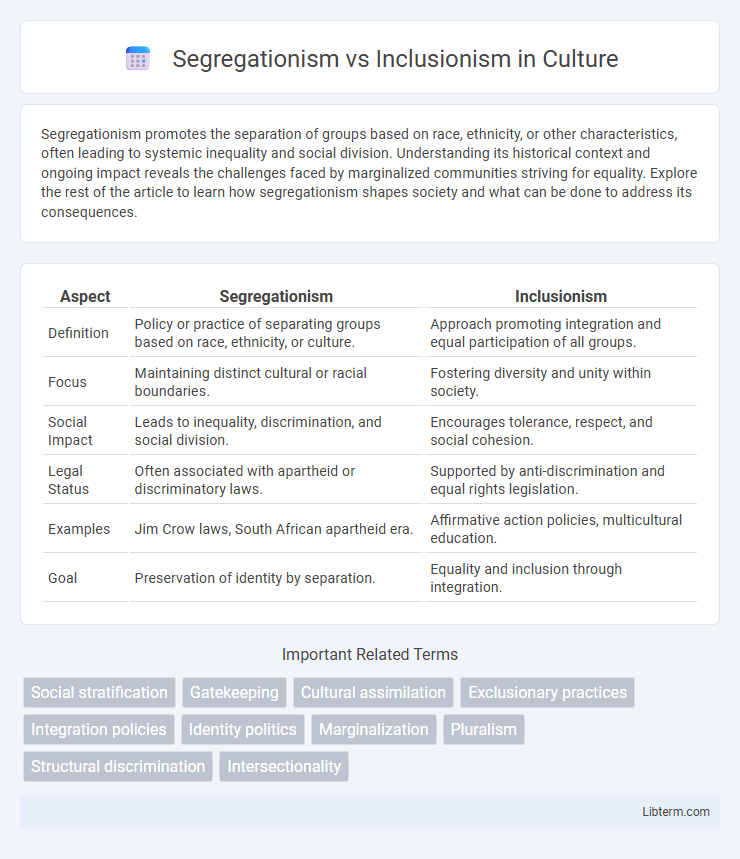Segregationism promotes the separation of groups based on race, ethnicity, or other characteristics, often leading to systemic inequality and social division. Understanding its historical context and ongoing impact reveals the challenges faced by marginalized communities striving for equality. Explore the rest of the article to learn how segregationism shapes society and what can be done to address its consequences.
Table of Comparison
| Aspect | Segregationism | Inclusionism |
|---|---|---|
| Definition | Policy or practice of separating groups based on race, ethnicity, or culture. | Approach promoting integration and equal participation of all groups. |
| Focus | Maintaining distinct cultural or racial boundaries. | Fostering diversity and unity within society. |
| Social Impact | Leads to inequality, discrimination, and social division. | Encourages tolerance, respect, and social cohesion. |
| Legal Status | Often associated with apartheid or discriminatory laws. | Supported by anti-discrimination and equal rights legislation. |
| Examples | Jim Crow laws, South African apartheid era. | Affirmative action policies, multicultural education. |
| Goal | Preservation of identity by separation. | Equality and inclusion through integration. |
Understanding Segregationism and Inclusionism
Segregationism advocates for the separation of groups based on race, ethnicity, or other characteristics, emphasizing distinct social, educational, or residential boundaries. Inclusionism promotes integrating diverse populations within shared spaces, fostering equal access, participation, and representation across social, educational, and institutional environments. Understanding these concepts is essential for addressing policies on civil rights, social equity, and multicultural coexistence.
Historical Roots of Segregationism
Segregationism originated in the post-Reconstruction era of the United States, where Jim Crow laws institutionalized racial separation and disenfranchisement of African Americans. This policy was reinforced by Supreme Court decisions such as Plessy v. Ferguson in 1896, which upheld "separate but equal" doctrines. The legacy of segregationism profoundly influenced social, economic, and educational disparities that inclusionism later sought to dismantle through civil rights movements and legislation.
Evolution and Principles of Inclusionism
Inclusionism evolved as a response to segregationist policies, promoting the principle that all individuals, regardless of differences, deserve equal access and participation in social, educational, and professional environments. It emphasizes diversity, equity, and the dismantling of systemic barriers through proactive integration and support for marginalized groups. Core principles include mutual respect, cultural competence, and the celebration of diverse perspectives to foster collaboration and social cohesion.
Key Differences Between Segregationism and Inclusionism
Segregationism enforces separation of groups based on race, ethnicity, or social status, often resulting in unequal access to resources and opportunities. Inclusionism promotes integration and equal participation of diverse groups within shared spaces, emphasizing acceptance and equity. Key differences lie in their impacts on social cohesion, with segregationism fostering division and marginalization, whereas inclusionism encourages collaboration and mutual respect.
Societal Impact of Segregationist Policies
Segregationist policies historically enforced racial and social divides, leading to systemic inequalities in education, housing, and employment that persist across generations. These policies entrenched socioeconomic disparities, limited access to resources, and fostered social fragmentation, undermining social cohesion and economic mobility. The long-term societal impact includes increased racial tensions, reduced economic growth potential, and ongoing challenges in achieving equitable opportunities for marginalized communities.
Benefits of Embracing Inclusionism
Embracing inclusionism fosters diverse perspectives that drive innovation and improve problem-solving across organizations and communities. Inclusive environments enhance employee engagement and satisfaction, leading to higher productivity and reduced turnover rates. Additionally, inclusionism promotes social equity by ensuring equal opportunities and representation for marginalized groups, contributing to a more just and cohesive society.
Case Studies: Segregationism vs Inclusionism in Education
Segregationism in education often leads to unequal resource distribution and academic disparities among marginalized groups, as evidenced by the historical case of the U.S. "separate but equal" doctrine overturned by Brown v. Board of Education (1954). Inclusionism, demonstrated by initiatives such as the Individuals with Disabilities Education Act (IDEA), promotes equitable access by integrating students with disabilities into mainstream classrooms, improving social and academic outcomes. Case studies from countries like Finland reveal that inclusive education models contribute to higher overall student performance and reduced achievement gaps.
Government Policies: Dividing or Uniting Societies?
Government policies on segregationism enforce boundaries in education, housing, and employment, perpetuating social divisions and inequality by systematically excluding marginalized groups. In contrast, inclusionism promotes policies that ensure equal access to resources, representation, and participation, fostering social cohesion and reducing disparities. The effectiveness of such policies significantly impacts societal unity, economic opportunities, and the protection of human rights in diverse populations.
Overcoming Barriers to Inclusion
Overcoming barriers to inclusion involves dismantling structural inequalities and promoting equitable access to resources for marginalized groups. Implementing inclusive policies in education, employment, and community engagement fosters diverse environments where all individuals can thrive regardless of background. Addressing unconscious biases and cultural misunderstandings is essential to creating sustainable inclusion beyond mere integration.
The Future Outlook: Towards a More Inclusive Society
Emerging social policies and educational reforms prioritize inclusionism, promoting diverse representation and equal access across all sectors to dismantle systemic barriers created by segregationism. Technological advancements and community-driven initiatives foster environments where marginalized groups actively shape cultural narratives and economic opportunities. Data from recent equity studies indicate a strong correlation between inclusive practices and improved societal cohesion, economic growth, and reduced social disparities, signaling a transformative shift toward a more equitable future.
Segregationism Infographic

 libterm.com
libterm.com